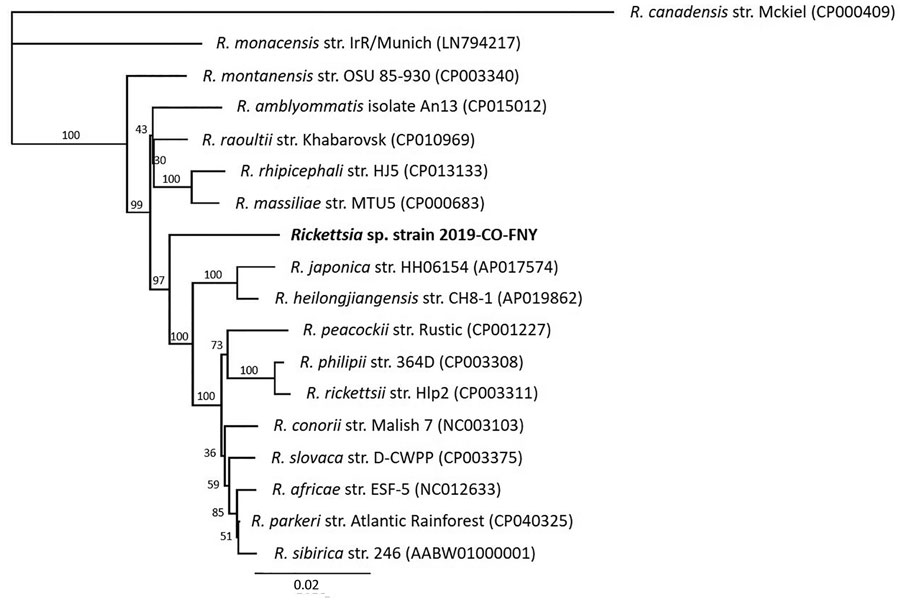Volume 26, Number 12—December 2020
Dispatch
Novel Rickettsia Species Infecting Dogs, United States
Figure

Figure. Multilocus phylogenetic tree of Rickettsia spp. obtained from a dog with Rocky Mountain spotted fever–type symptoms in 2019 (bold) compared with reference sequences. We noted 3 dogs with RSMF symptoms. Rickettsia DNA were identical among all 3 cases; however, complete sequences from all 5 regions were obtained only from case 3, which we used to represent the novel Rickettsia species strain 2019-CO-FNY. We used 2,576 nucleotides concatenated from regions within 3 genes (gltA, htrA, and ompA) and 2 intergenic spacer regions (23S-5S and mmpA-purC). We used the maximum-likelihood method and Tamura-Nei model (6,7) optimized for branch length, topology, and substitution rate to assemble the tree by using the PhyML 3.3.20180621 plugin in Geneious Prime 11.0.0+7 (https://www.geneious.com). Numbers at nodes indicate bootstrap percentages obtained from 1,000 resamplings. Numbers in parentheses are GenBank accession numbers. The tree is drawn to scale. Scale bar indicated the number of nucleotide substitutions per site.
References
- Straily A, Stuck S, Singleton J, Brennan S, Marcum S, Condit M, et al. Antibody titers reactive with Rickettsia rickettsii in blood donors and implications for surveillance of spotted fever Rickettsiosis in the United States. J Infect Dis. 2020;221:1371–8.PubMedGoogle Scholar
- Warner RD, Marsh WW. Rocky Mountain spotted fever. J Am Vet Med Assoc. 2002;221:1413–7. DOIPubMedGoogle Scholar
- Hardstone Yoshimizu M, Billeter SA. Suspected and confirmed vector-borne rickettsioses of North America associated with human diseases. Trop Med Infect Dis. 2018;3:2. DOIPubMedGoogle Scholar
- Yancey CB, Hegarty BC, Qurollo BA, Levy MG, Birkenheuer AJ, Weber DJ, et al. Regional seroreactivity and vector-borne disease co-exposures in dogs in the United States from 2004-2010: utility of canine surveillance. Vector Borne Zoonotic Dis. 2014;14:724–32. DOIPubMedGoogle Scholar
- Drexler NA, Dahlgren FS, Heitman KN, Massung RF, Paddock CD, Behravesh CB. National surveillance of spotted fever group rickettsioses in the United States, 2008–2012. Am J Trop Med Hyg. 2016;94:26–34. DOIPubMedGoogle Scholar
- Tamura K, Nei M. Estimation of the number of nucleotide substitutions in the control region of mitochondrial DNA in humans and chimpanzees. Mol Biol Evol. 1993;10:512–26.PubMedGoogle Scholar
- Guindon S, Dufayard JF, Lefort V, Anisimova M, Hordijk W, Gascuel O. New algorithms and methods to estimate maximum-likelihood phylogenies: assessing the performance of PhyML 3.0. Syst Biol. 2010;59:307–21. DOIPubMedGoogle Scholar
- Gasser AM, Birkenheuer AJ, Breitschwerdt EB. Canine Rocky Mountain Spotted fever: a retrospective study of 30 cases. J Am Anim Hosp Assoc. 2001;37:41–8. DOIPubMedGoogle Scholar
- Raghavan RK, Barker SC, Cobos ME, Barker D, Teo EJM, Foley DH, et al. Potential spatial distribution of the newly introduced long-horned tick, Haemaphysalis longicornis in North America. Sci Rep. 2019;9:498. DOIPubMedGoogle Scholar
- Xu H, Zhang Q, Guan H, Zhong Y, Jiang F, Chen Z, et al. High incidence of a novel Rickettsia genotype in parasitic Haemaphysalis longicornis from China-North Korea Border. Sci Rep. 2019;9:5373. DOIPubMedGoogle Scholar
- Ando S, Kurosawa M, Sakata A, Fujita H, Sakai K, Sekine M, et al. Human Rickettsia heilongjiangensis infection, Japan. Emerg Infect Dis. 2010;16:1306–8. DOIPubMedGoogle Scholar
- Vitale G, Mansuelo S, Rolain J-M, Raoult D. Rickettsia massiliae human isolation. Emerg Infect Dis. 2006;12:174–5. DOIPubMedGoogle Scholar
- Estrada I, Balagot C, Fierro M, Kriner P, Iniguez-Stevens E, Kjemtrup A, et al. Spotted fever group rickettsiae canine serosurveillance near the US-Mexico border in California. Zoonoses Public Health. 2020;67:148–55. DOIPubMedGoogle Scholar
- Smith FD, Ballantyne R, Morgan ER, Wall R. Estimating Lyme disease risk using pet dogs as sentinels. Comp Immunol Microbiol Infect Dis. 2012;35:163–7. DOIPubMedGoogle Scholar